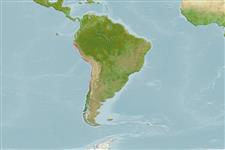Elasmobranchii (Haie und Rochen) (sharks and rays) >
Rajiformes (Skates and rays) >
Arhynchobatidae (Softnose skates)
Etymology: Sympterygia: Greek, syn, symphysis = grown together + Greek, pteryx = fin (Ref. 45335).
More on author: Cope.
Issue
Four nominal species of Psammobatis (asper, caudispina, chilcae, maculatus), all from Hildebrand, 1946, are considered valid in Eschmeyer (CofF ver. May 2011: Ref. 86870) following Chirichigno & Vélez (1998), but J. McEachran confirmed their synonym status of Sympterygia brevicaudata (Cope, 1877) (pers. comm., 11/2003).
Environment: milieu / climate zone / depth range / distribution range
Ökologie
seewasser demersal; tiefenbereich ? - 18 m (Ref. 58018). Subtropical; 3°S - 37°S
Southeast Pacific: Ecuador to central Chile. Two specimens have been recorded from Uruguay but these may be in error.
Size / Gewicht / Alter
Maturity: Lm ? range ? - ? cm
Max length : 38.0 cm TL Männchen/unbestimmt; (Ref. )
Oviparous (Ref. 50449). Eggs have horn-like projections on the shell (Ref. 205). Max. length (Johnny Labbe, pers. comm., 2000).
Life cycle and mating behavior
Geschlechtsreife | Fortpflanzung | Ablaichen | Eier | Fecundity | Larven
Oviparous, paired eggs are laid. Embryos feed solely on yolk (Ref. 50449).
McEachran, J.D. and K.A. Dunn, 1998. Phylogenetic analysis of skates, a morphologically conservative clade of elasmobranchs (Chondrichthyes: Rajidae). Copeia 1998(2):271-290. (Ref. 27314)
IUCN Rote Liste Status (Ref. 130435)
Bedrohung für Menschen
Harmless
Nutzung durch Menschen
Mehr Information
Alter/Größe
Wachstum
Länge-Gewicht
Länge-Länge
Längenhäufigkeiten
Morphometrie
Morphologie
Larven
Larven Pop.Dyn.
Rekrutierung
Dichte
BRUVS
ReferenzenAquakulturAquakultur ProfilZuchtlinienGenetikElectrophoresesVererbbarkeitKrankheitenVerarbeitungNutrientsMass conversion
PartnerBilderStamps, Coins Misc.LauteCiguateraGeschwindigkeitSchwimmstilKiemenoberflächeOtolithsGehirngrößeSehfähigkeit
Tools
Zusatzinformationen
Download XML
Internet Quellen
Estimates based on models
Preferred temperature (Ref.
123201): 15.3 - 21, mean 19.5 °C (based on 100 cells).
Phylogenetic diversity index (Ref.
82804): PD
50 = 0.5625 [Uniqueness, from 0.5 = low to 2.0 = high].
Bayesian length-weight: a=0.00550 (0.00273 - 0.01106), b=3.10 (2.93 - 3.27), in cm total length, based on LWR estimates for this (Sub)family-body shape (Ref.
93245).
Trophic level (Ref.
69278): 3.7 ±0.7 se; based on size and trophs of closest relatives
Widerstandsfähigkeit (Ref.
120179): niedrig, Verdopplung der Population dauert 4,5 - 14 Jahre. (Assuming fecundity<100).
Fishing Vulnerability (Ref.
59153): Low to moderate vulnerability (28 of 100).
Nutrients (Ref.
124155): Calcium = 42.7 [6.6, 208.3] mg/100g; Iron = 0.876 [0.232, 2.569] mg/100g; Protein = 17.6 [14.9, 20.1] %; Omega3 = 0.444 [0.145, 1.605] g/100g; Selenium = 11 [3, 37] μg/100g; VitaminA = 17.9 [5.8, 55.9] μg/100g; Zinc = 0.73 [0.34, 1.35] mg/100g (wet weight);
